Keywords
|
| Z-scan, Zigzag Scan, Intra coding, AVS, Coding Efficiency, H.264/AVC. |
INTRODUCTION
|
| The Audio Video Coding Standard (AVS) is a China’s national standard for media compression, which is developed by Audio and Video Coding Standard Working Group of China. Similar with H.264/AVC video coding standard, AVS is a block transform-based codec uses a run length coding technique to encode the quantized coefficients corresponding to a particular prediction residual block. Run length coding proceeds by zigzag scanning a block of quantized transform coefficients with a pre-defined pattern. In AVS intra coding, there are 5 different intra prediction methods for 8x8 blocks are supported [1]. In general, different intra prediction method can introduce different prediction residual. Therefore, it is inefficient for coding the residual signal predicted from different directions with only zigzag scan being used. |
| Recently, to resolve this problem, many works have been done on developing a suitable san pattern for various video coding standards. For MPEG-4 intra coding, three block-level adaptive scans (alternate-vertical, alternate-horizontal and zigzag) for each intra blocks according to DC prediction direction was utilized in [2]. For H.264/AVC intra coding, [3], [4], [6] proposed to use two extra scan patterns for vertically predicted block and horizontally predicted block respectively, and the traditional zigzag scan was used for other prediction modes. Similarly, in [5], they proposed an adaptive scan method that used a different scan method for each intra prediction mode. For AVS standard, depending on the statistical distribution of prediction residual, an new scheme called MLASS that adaptively choose the best scan pattern for each macroblock to arrange the quantized DCT coefficients was presented in [7], moreover, it can not only be used for intra coding but also for inter coding. |
| In this paper, inspired by the above research works, we propose a z-scan scheme for AVS intra coding which can further improve coding efficiency on bit rate saving. Within this scheme, according to the spatial prediction directions, two additional scan table called horizontal z-scan and vertical z-scan are used together with normal zigzag scan to organize coefficients. In the following sections, brief overview of AVS intra coding process will be given in section II. Section III presents the detailed z-scan scheme design. The experimental results of our proposed method are provided in section IV. Finally, conclusion and future work are discussed in section V. |
OVERVIEW OF AVS INTRA CODING
|
| AVS intra coding is similar with H.264/AVC except that the prediction process is conducted for each 8x8 luma/chorma block in the spatial domain. Residual spatial redundancy is removed by spatial prediction and transform coding. The general block diagram of the AVS intra encoder can be seen in Fig.1. |
| A. Intra prediction and transform |
| For the intra prediction part in Fig.1, intra blocks of intra frames and intra-coded macroblocks in P- and B-frames are spatially predicted from previously encoded and reconstructed neighbouring blocks. For the luma samples, there are five directional intra modes for each 8×8 block: |
| Vertical (mode 0), Horizontal (mode 1), DC (mode 2), Down-left (mode 3) and Downright (mode 4). |
| Fig. 2 illustrates the process of 8x8 intra prediction. To encode a luma block, 16 previously decoded pixels above and to the right of the current block together with 16 previously decoded pixels to the left and below of the current block will be used to predict current block pixels. The best prediction mode for each block in terms of RD performance is selected in mode selection part. After intra prediction, AVS performs a separable, 8x8 integer cosine transform (ICT) on the residual block for energy compaction and followed by a quantization to minimize coding complexity. |
| B. Zigzag Scan and Challenge |
| For binary coding of the quantized transform coefficients, these coefficients are mapped into a 1-D array following the zigzag order shown in Fig.3. Thus, bigger low-frequency coefficients are put in front of the high frequency coefficients that are usually zero-valued. |
| As we know, zigzag scan can efficiently group coefficients of transform typical image block for image coding systems, for instance, JPEG2000. In directional spatial prediction based video coding systems, however, it may not be ideal for organizing transform coefficients. We have observed that the pattern of likely coefficients in a transform residual block shows some kind of local data dependency. Different texture regions in video sequence decides different optimal prediction mode, meanwhile, different intra prediction mode leads to different residual coefficient distribution. Consequently, one fixed scan pattern cannot be always ideal (in the sense of reducing the required bits of representing current block) for every block with various kinds of texture features. |
| For example, blocks that use vertical or horizontal prediction modes as the best modes show different frequency change features from blocks that use the other prediction modes [3]. We, hereby, focus on the vertical prediction and horizontal prediction. When a block is assigned the vertical prediction modes, the vertical predicted residual pixels will have a high correlation in the vertical direction; therefore, in the frontal up rows, the transform coefficients will have relatively large values which are not likely to be quantized to zero. In a similar way, when a block uses horizontal intra prediction, the transform coefficients in the frontal left columns are less likely to be quantized to zero due to their relatively large value. |
| However, zigzag scan used in AVS is utilized without considering the specific transform coefficients distribution characteristics that are stated above. As can be seen in Fig.3, zigzag scan is particularly suitable for symmetric coefficient distribution, because it scans along the horizontal direction and the vertical direction with the same priority. Therefore, zigzag scan cannot efficiently organize coefficients while vertical prediction or horizontal predictions are being used. Meanwhile, the entropy coding efficiency will be decreased because less non-zero coefficients are grouped together. |
| In order to further improve the coding efficiency, our target is to design a better scanning method that can take advantage of specific distribution features of different intra prediction modes. |
METHODOLOGY OF Z-SCAN SCHEME
|
| Based on above analysis, we proposed a new z-scan scheme. As shown in Figure 3, two scan patters are added to the proposed scheme: Horizontal z-scan (Fig.4) and Vertical z-scan (Fig. 5). |
| Similarly, Vertical z-scan will be used when a block is intra predicted by horizontal mode. Also starting from the topleft position; it scans each position as z-shape unit columns by columns from left to right. All coefficients in the vertical direction are read faster than those in horizontal direction; non-zero coefficients can be grouped more efficiently in vertical direction. When the current block uses the other three kinds of prediction modes: DC, Down-left and Downright, the conventional zigzag scan will be used to organize the transform coefficients. |
| According to the description above, the scan function of AVS standard is added into two new scan patterns, thus, we have three scan tables including zigzag scan exist in new AVS codec. The new scan process can be performed as follows: |
| (i) For each individual block, before scan, the prediction mode of the current block will be informed by the intra prediction function. |
| (ii) For each individual block, before scan, the prediction mode of the current block will be informed by the intra prediction function. |
| (iii) Intra prediction mode will be used as the signal of deciding the scan patter. Blocks using Vertical prediction will choose Horizontal z-scan, blocks using Horizontal prediction will choose Vertical z-scan, and blocks using other three prediction modes choose zigzag scan. |
| (iv) Scan the transform coefficients block with corresponding scan pattern. |
| It should be noticed that there are no extra bits for representing signal of intra prediction mode for current block, since it can be directly derived from intra prediction function just before scan function in AVS codec. |
EXPERIMENTAL RESULTS
|
| We present the experimental results in this section. The test model avs_sm0.4 (Jizhun Profile) developed by China AVS group is used to evaluate the performance of proposed z-scan scheme. All of test conditions can be found in Table I. Test results about four sequences with different QPs are illustrated in Table II. |
| The 2nd column shows the different QPs using in our experiments, it can be seen that our method outperforms conventional AVS for every QP, so that our scheme is quantization parameter independent. The last column demonstrates that, under every condition, the proposed z-scan scheme can averagely save approximately 2.07% bits compared to conventional AVS standard with only zigzag scan being used. Furthermore, it can achieve a maximum bitrates saving of 3.4%. More importantly, as shown in 3rd and 5th column, our z-scan scheme can obtain similar PSNR values while reducing the bitrates significantly. |
| For each sequence, considering that the coarser quantization parameter being used the more coefficients will be quantized to zero. Therefore, it is easier for our z-scan method to efficiently group more zero coefficients together after less consecutive non-zero values. In this way, greater performance improvement can be obtained when the QP is higher. |
| For City (4CIF) sequence, the video texture is so complex that it is less to utilize simple vertical or horizontal mode to predict. For this reason, there is not much improvement for City (4CIF) sequence. For Foreman (CIF) sequence, there is even small room for coding efficiency improvement due to more flat areas and less complex image texture. For Paris (CIF) and Soccer (4CIF) sequences, they exhibit the common feature of relatively simple and fixed background. This feature leads to more blocks are predicted with vertical and horizontal modes. Thus, within our proposed method, more bitrates can be saved. Since improvement of intra coding is difficult to achieve, as widely known, the bitrates saving in our experiments is obviously significant especially almost without quality reduction. |
CONCLUSIONS AND FUTURE WORKS
|
| In this paper, we proposed a new z-scan method for directional spatial prediction of AVS intra coding. Each block chooses the appropriate scan mode from three scan tables according to its intra prediction mode. Experimental results demonstrated that after implementation of our new scan modes, the intra coding efficiency in terms of RD performance can outperform the conventional fixed zigzag scan pattern for all test sequences regardless of the test conditions. Besides, there is no extra computational cost in our z-scan implementation. To develop a quick z-scan method without sending the prediction mode of current block will be researched both at the encoder and decoder. |
Tables at a glance
|
 |
 |
| Table 1 |
Table 2 |
|
| |
Figures at a glance
|
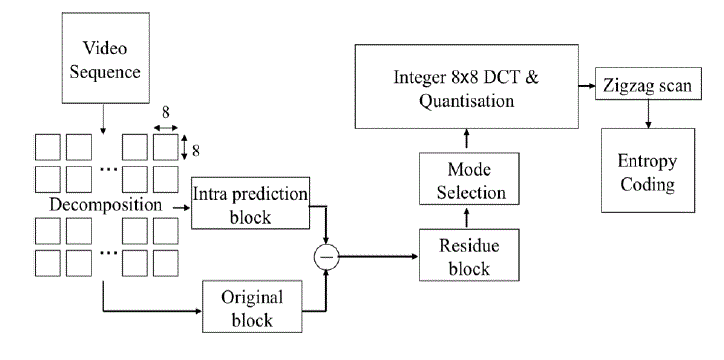 |
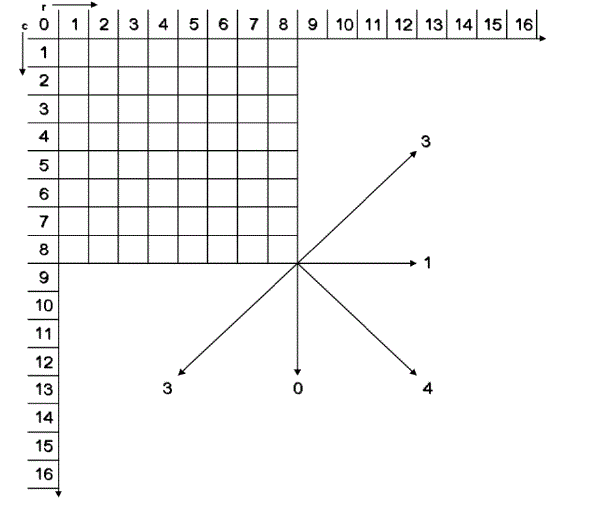 |
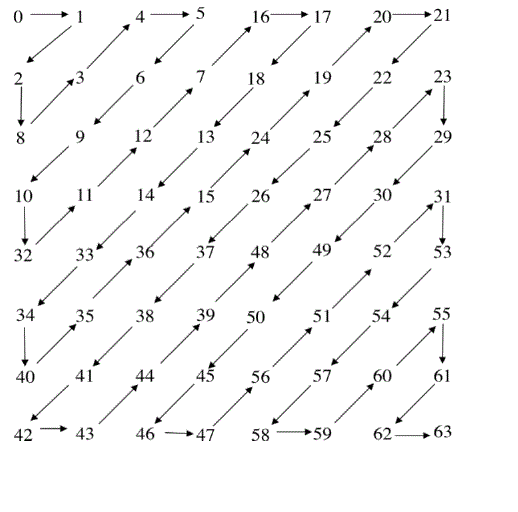 |
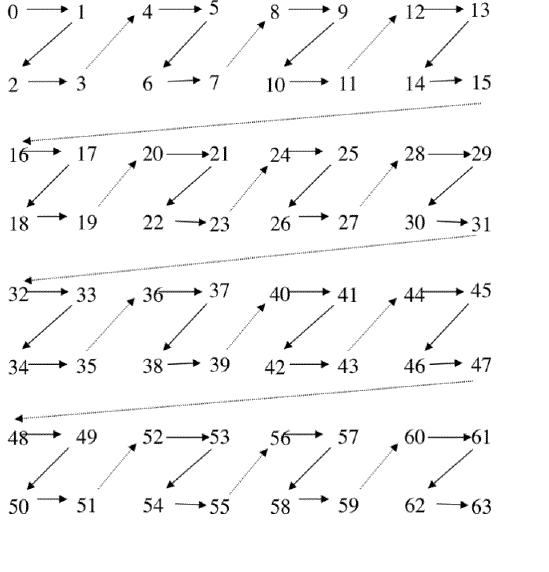 |
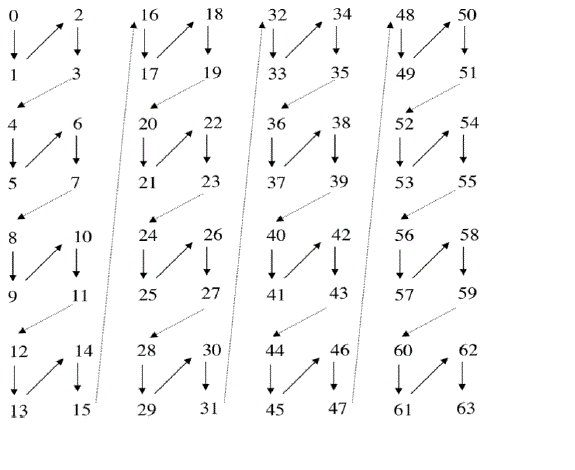 |
| Figure 1 |
Figure 2 |
Figure 3 |
Figure 4 |
Figure 5 |
|
| |
References
|
- Final draft of information technology – advanced coding of audio and video – part 2: video, AVS workgroup Doc. N1214, Shanghai, China, Sep.2005.
- ISO/IEC JTC 1/SC 29/WG 11: Coding of audio-visual objects – Part 2: Visual Amendment 1(MPEG-4), N3056, Hawaii (Maui), US, 1999.
- JiaJie, Jung Eun-Ku, Kim Hae-Kwang, “Adaptive Transform Coefficient Scan for H.264 Intra Coding, IEICE (E90-D),” No. 10, October 2007, pp. 1709-1711.
- Y.-L. Lee, K.-H. Han, D.-G. Sim, and J. Seo, “Adaptive Scanning for H.264/AVC Intra Coding,” ETRI Journal, vol. 28, no. 5, pp. 668-667, Oct. 2006.
- Byeong-Doo Choi, Jin-Hyung Kim, and Sung-JeaKo, "Adaptive Coefficient Scanning Based on the Intra Prediction Mode," ETRI Journal, vol.29, no.5, pp.694-696, Oct. 2007.
- X.Fan, Y.Lu and W.Gao, “A Novel Coefficient Scanning Scheme For Directional Spatial Prediction-Based Image Compression,” IEEE International Conference on Multimedia & Expo (ICME), pp.II/557- 560, Jul. 2003.
- Li Zhang, Wen Gao, Qiang Wang and Debin Zhao, "Macroblock-Level Adaptive Scan Scheme for Discrete Cosine Transform Coefficients," IEEE International Symposium on , vol., no., pp.537-540, 27-30 May 2007.
|